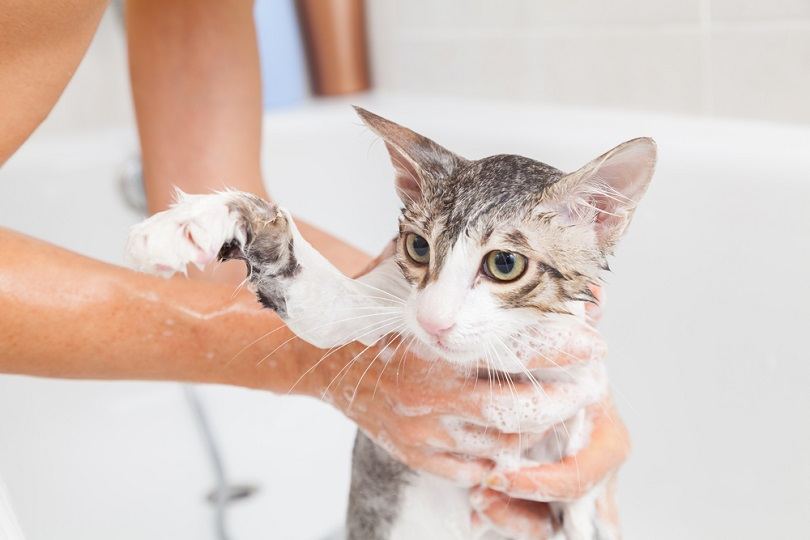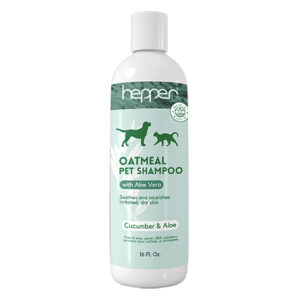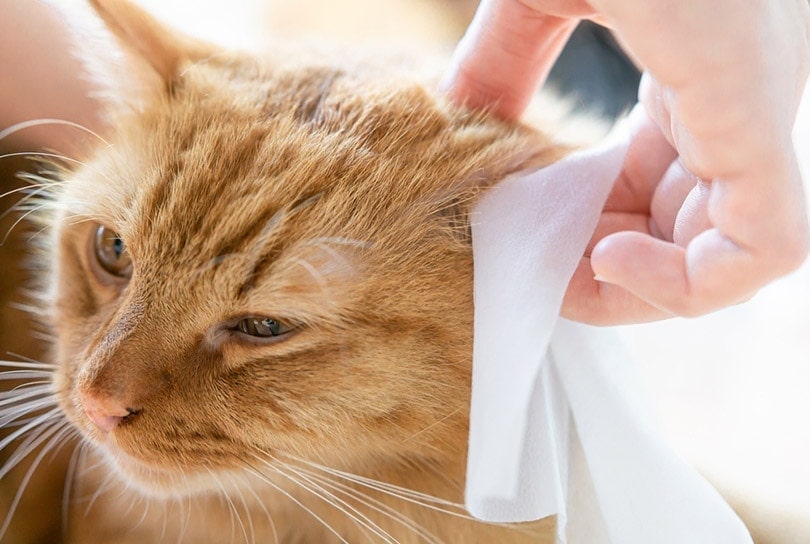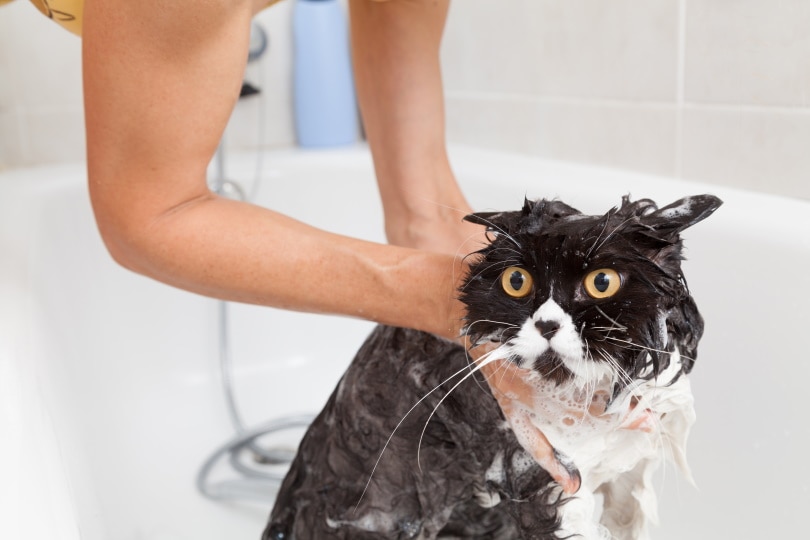
If you have a cat who really prefers not getting wet, bath time can be pretty tricky. If you have a frantic kitty, claws will be out and ready to clutch onto something, like the skin of your arm—ouch!
If you have a cat who has a hard time accepting the process, you can consider these ten tips to make things easier on both of you. Keeping your cat calm is vital. Even if they don’t particularly like the baths, you might be able to coax them into accepting it long enough to get them clean.
The 10 Ways to Calm a Cat for a Bath
1. Set Up the Ideal Bath
Some cats prefer a smaller space, while others want a big bath. And others, it doesn’t matter what kind of bath it is, they aren’t having it.
If you choose to have a still bath, you need to make sure to have a small cup or pitcher to gently pour the water on the fur to wash away the shampoo of your choice. The important thing is not to skip on the cleanliness of the cat.
Even if your cat is not enjoying the time that they’re spending in the tub, you need to make sure to get all of the debris out of there by thoroughly saturating and scrubbing them down. If you’re new to bathing this particular cat, it can take a while to get used to the process.
After all, you both need to learn from each other and understand the likes and dislikes of your cat so that you can meet somewhere in the middle. Also, you’re going to want to use a method that is easy for you to handle your cat.
Many people like to give their cat a bath and a sink or washtub that is small and easy to reach. However, some highly frantic cats might try to get away quite quickly in this situation. If so, bathing your cat in a large tub with a helper might be the only way to go.
If you are just gently removing some debris from the fur, and it doesn’t require a full-fledged bath, you can always use sponges or a moist cloth to bathe your cat. They may hate that least of all.
Giving your pet a bath can be a difficult task, but the first step is to choose a great shampoo. We love Hepper's Shampoo Products, both of which are natural, pet-safe options specially formulated to clean your pet's skin and coat without causing irritation. Both formulas are also free of things like dyes, soaps, sulfates, and phthalates. Your pet will enjoy the soothing aloe vera and oatmeal, and you'll love the clean, fresh scents!
 |
 |
|
|---|---|---|
| Hepper Colloidal Oatmeal Pet Shampoo | Hepper Waterless No Rinse Pet Shampoo | |
| Natural Ingredients |
Natural Ingredients:
|
Natural Ingredients:
|
| Made in USA |
Made in USA:
|
Made in USA:
|
| Safe for cats & dogs |
Safe for cats & dogs:
|
Safe for cats & dogs:
|
| Soothes dry skin |
Soothes dry skin:
|
Soothes dry skin:
|
| Waterless, no rinsing required |
Waterless, no rinsing required:
|
Waterless, no rinsing required:
|
At Pet Keen, we've admired Hepper for many years, and decided to take a controlling ownership interest so that we could benefit from the outstanding designs of this cool cat company!
2. Protect Your Cat and Yourself
Cat claws are no joke, and it can be challenging to avoid them in close situations like this. If you leave your skin exposed or have thin layers on, you can get some pretty wicked cuts, which can lead to infection.
Also, if you get hurt, you might panic your cat even more by reacting. The entire idea is to avoid any injury to yourself and prevent startling your cat further. Many people prefer to wear long sleeves.
But you can put thicker measures in place by getting a towel or other absorbent cloth to have as a barrier between the two of you.
Even if we have beloved house cats, you can still get infections, like cat scratch fever, if your cat is to scratch or bite you during a bath. This condition, for instance, is when your lymph nodes swell significantly following the scratch or bite.
This bacterial infection is very rare but still possible. Plus, regardless of infection, cat scratches just hurt. So, putting proper measures in place, especially if the cat you are bathing is new or this is their first time, is necessary.

3. Have a Helper Close By
Some cats are almost impossible to hold and scrub with only one person. It’s incredible how agile and fierce your cat can be when they’re in a state of fear and ready to escape. Even if you have a big, lazy guy or gal, they can turn into a ninja under stress.
If your cat is a wiggle monster constantly trying to escape you, having another person there to make sure your cat gets clean is one of the best solutions.
In order to avoid terrifying your cat out even more, always make sure it is a person they equally trust. You won’t want a complete stranger to try to calm down a cat that is already out of its element and feeling extremely anxious.
You both can take on different roles. One of you can hold the cat to soothe and calm them while the other scrubs and rinses. One of you can be fully prepared with a towel waiting to get the cat out of the tub while the other one finishes the process.
Teamwork is a great thing if that is in the cards for you. Of course, in some situations having a helper is not a possibility—and we understand that.
4. Wipes Are Your Friend
If your cat is already pretty uncertain about last time, it’s definitely not a good idea to submerge them or pour water on their face.
Even if you don’t have a particularly wiggly cat, you can still easily get water down in the air canals if you’re not careful. It’s best to avoid pouring water on the head if at all possible.
Instead, you can use wipes to clean the areas around the eyes, nose, and ears. You might find that this is a lot easier to do, and it makes your cat feel more secure. You can find utterly cat face wipes on sites like Chewy.
You can also find these at pet shops and other commercial stores. Even outside of bath time, it can be an incredibly useful tool to have if your cat gets any mess in there or needs a quick wipe down.

5. Don’t Use Running Water
Leaving the water running while you’re giving your cat a bath can be an extremely big sound trigger for your cat. Hearing the loud noise can increase their anxiety which will make them feel even more uncomfortable.
It’s best to draw a nice lukewarm bath first so that you can gently place your cat in and then use a cup to pour the water over them and saturate the fur. You might have to have a small tub of clean water on standby.
Once you put the cat shampoo of your choice on your cat, you need to rinse it thoroughly without leaving residue on the fur.
6. Consider Aromatherapy
It’s pretty much impossible to walk through any kind of department store without seeing aromatherapy products. If you are buying a product to soothe you in a bath, the chances are that you will see ingredients like chamomile and lavender for humans.
You must be aware that not all human products are safe to use on cats, so you should look for cat-specific products that have been proven safe for felines.
Sites like Chewy and Amazon are crawling with aromatherapy options for pets. One of the ways that we recommend making a decision during purchase is to read the reviews of consumers.
If you have other cat lovers who appreciate their felines as much as you do, they also want a product that’s equally fantastic. If it’s successful for someone else, the chances are much higher that it will be successful in a similar situation.
If you are unsure about the safety of any product, always check with your veterinarian to see what they recommend.
They might even have a recommendation they can give you right there in the office so you can take it home to try it. Typically, your cat won’t need any medication, but in extreme anxiety cases, your vet might suggest giving them some type of sedative to relax their nerves.

7. Offer Treats
If your cat is anything like most felines, they aren’t going to turn down a yummy snack. You can always have treats on hand for your cat to deter their attention and help calm them down.
Even though you can give them crunchy treats, it might be a much better option to provide them with something that’s just easy to lick up. If you have a helper, you might be able to let them hold up an accessible treat to munch on while you do the dirty work.
This distraction is incredibly effective, just be careful not to overdo it. You don’t want to make your cat sick in the meantime, especially if their nerves are up. The last thing you want is to clean up vomit if your cat gets too worked up during the process.
8. Make It Quick, But Take It Slow
Did that sound confusing? Let us explain what we mean. If your cat is under a great deal of stress, you don’t want to keep them in the bath any longer than necessary.
But also, you want to make slow, gentle movements so that you don’t freak them out anymore than they already are. Once you give your cat a bath, you might have the system down pat a little.
Saturate, apply shampoo, scrub thoroughly, and rinse efficiently. All this is really only a four-step process, moving too quickly can make your cat feel out of control.
Your Energy Can Influence Your Pet
Also, if you know your cat is stressed, and you let that stress you out, they can actually feel your energy. If they see that their own human isn’t feeling very calm, it’s going to be hard to convince them that they need to be.
Because of the language barrier between us and our buddies, you can explain to them that you are just worked up because you know how much they despise baths and you want to make it as easy on them as you can.
What’s interesting about our cats is that they can pick up on our emotions and stress levels based on our body language and facial expressions. If they notice their human is just as tense as they are, they are not going to trust the situation.
So, make it a point to talk to your cat in a calming voice and use gentle movements during the process. The best way that you can quickly and efficiently clean your cat is to calmly get the job done.

9. Use Anti-Skid Mats
We have all nearly taken a spill in the tub because of the slippery floor, suds and all. Your cat is not going to have any additional traction than that. If they are trying to move around, they’re going to be slipping and falling, creating even more of a ruckus.
If you have an anti-skid mat down during bath time, it can help your cat’s feet stay firmly on the ground without creating more distress. Once again, sites like Amazon and Chewy are super terrific when it comes to supplying these products.
You can find one that fits nicely into the space you need by ensuring it has the proper measurements. As with anything else, make sure that the product is worth your money before purchase.
10. Compensate with Cuddles
After bath time, you will have to make up for what you’ve done. It’s time to queue the cuddles and snuggles. Praise your cat for a well-done job to provide them with the best aftermath experience.
They’re going to be cold and wet, two of their least favorite things. So it’s your job as a human caretaker to make sure that they are snuggled up in a warm spot, unable to recover from the stress they were under.
We think you will agree that this will be their absolute favorite part of bath time—the end.

How Often Should You Bathe Your Cat?
Bathing frequency depends a lot on the coat type and lifestyle of your cat. For instance, if you have an indoor/outdoor cat, they might need a wipe down or complete bath more frequently due to more dirt and debris on their fur.
Similarly, if you have a cat with exceptionally long hair that is prone to matting or tangling, there can be a little bit of a grooming problem there as well. Even the cleanest cats who are super tidy might have issues removing all of the dirt from their fur.
These cats, such as Persians, Himalayans, Maine Coons, and Domestic Longhairs, might need a little extra help. However, if you have a short-haired indoor cat, you can plan to bathe them on an as-needed basis.
A general rule of thumb is to wait at least 4 to 6 weeks between baths. As we described, it can be more or less depending on a few factors. However, under no circumstance should you bathe your cat any more than once a month. This can cause damage to the natural oils in the skin, causing dryness, irritation, and other potentially uncomfortable side effects.
Products to Use
Always make sure to use a shampoo that has been specially formulated for cats. Using human or even other pet shampoos on a cat can completely cause irritation and all sorts of other unwanted side effects.
Also, if your cat suffers from any skin-related allergies, it’s best to scour the ingredients first to make sure that there’s nothing in the formula that will irritate your pet’s skin.
Conclusion
Keeping your cat calm during a bath can be challenging at first. However, once you get a routine down and they get used to the process, it can be pretty seamless eventually. The two of you can learn what to do and what not to do, creating a stress-free environment where your cat can get clean and get out.
You can use one or all of these tips to help your kitty during bath time but use your best judgment. If you have any questions about any safety or anxiety issues during bath time, speak to your veterinarian or another feline professional to get some guidance.
See Also:
- How to Dry a Cat After a Bath (Without Getting Scratched)
- How to Calm a Cat for Grooming: 6 Tips & Tricks
Featured Image Credit: 135pixels, Shutterstock








